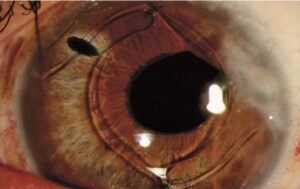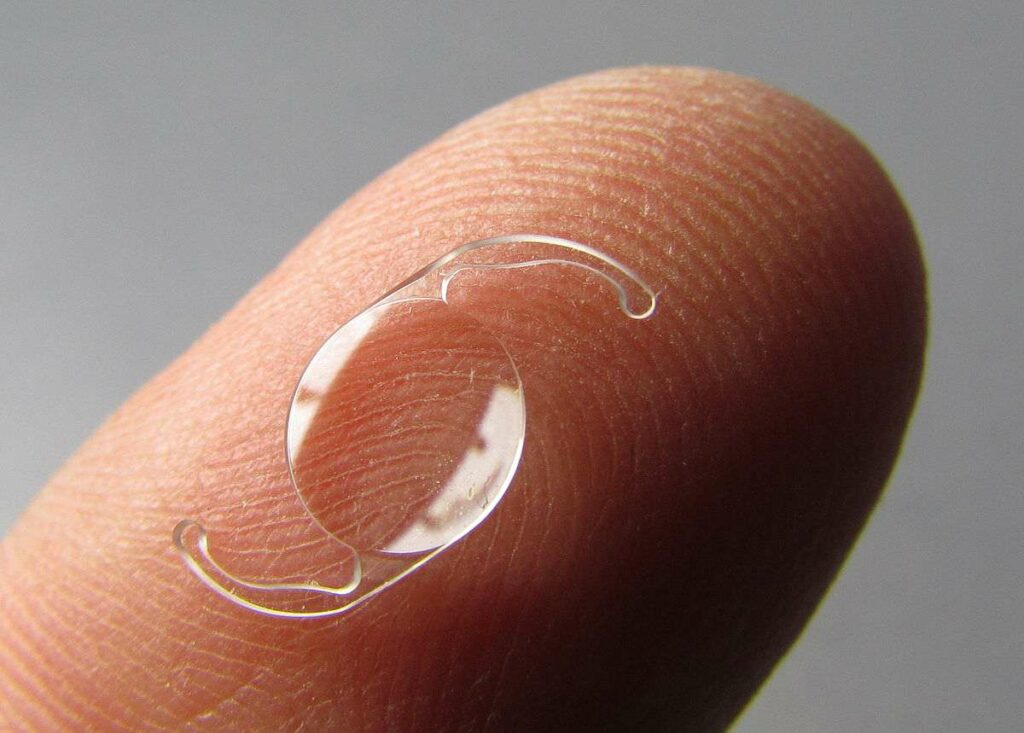If you are scheduled to have cataract surgery, your doctor will likely recommend an intraocular lens (IOL). But what is an IOL? What are the different types? This blog post will answer those questions and more. We’ll also discuss the benefits of IOLs and how they can improve your vision. So, read on to learn everything you need to know about intraocular lenses!
Contents
What Does Intraocular Lens Mean?
 An intraocular lens (IOL) is a tiny artificial lens that is implanted inside the eye to replace the natural crystalline lens after it has been removed during cataract surgery. This operation, called “cataract extraction,” involves making a small incision in the cornea. And then removing the cloudy, aged central portion of the eye’s lens through this incision.
An intraocular lens (IOL) is a tiny artificial lens that is implanted inside the eye to replace the natural crystalline lens after it has been removed during cataract surgery. This operation, called “cataract extraction,” involves making a small incision in the cornea. And then removing the cloudy, aged central portion of the eye’s lens through this incision.
This lens is typically described as a monofocal IOL that provides clear vision at only one distance. But there are now other options available, such as a multifocal IOL or an accommodating IOL. If you are considering IOL implantation, it’s important to understand what the procedure involves and what type of lens might be best for your eye health.
Different Types
There are two primary types of intraocular lenses (IOLs):
- Monofocal IOLs: These are the most common type of intraocular lenses used in cataract surgery. They allow you to focus on objects at one specific distance—either near, intermediate, or far. Depending on your needs and your eye doctor’s recommendation, you may have one or more monofocal lenses implanted.
- Multifocal IOLs: These lenses are designed to give you a range of vision so that you can see objects at multiple distances without the need for glasses or contact lenses. They are typically used in those with presbyopia, which is the common age-related loss of near vision.
These are the foremost types of IOLs, but there are also other types, including:
- Toric IOLs (which correct astigmatism)
- Accommodating IOLs (which can change focus over time)
- Extended range of vision (ERV) lenses
Your eye doctor will be able to discuss the best option for your needs. You should also discuss any potential risks and complications associated with the procedure before undergoing surgery.
Which IOL Is Most Popular?
While there are various types of IOLs available, the most popular type is the monofocal lens. This type of IOL focuses light from one distance, either near or far vision, and provides good clarity for that particular distance. Monofocal lenses come in both fixed focus (one-piece) and adjustable (multifocal) varieties.
Adjustable IOLs are becoming increasingly popular because they can offer good vision at multiple distances. They use a combination of lens elements to focus light from different distances and provide the patient with both near and far vision.
However, the type of lens that is best for your eyes may vary depending on your specific vision needs. Talk to your eye doctor or ophthalmologist about the pros and cons of different IOLs in order to determine which one is right for you.
How Is An Intraocular Lens Implanted?
In most cases, an IOL is surgically implanted into the eye. The procedure is quick and relatively painless. Generally, it requires only local anesthetic to numb the eye and surrounding area.
During the procedure, an ophthalmologist will make a small incision in the cornea of your eye. Through this incision, they will insert a tiny IOL which is then unfolded within your eye. This procedure is usually done in less than 15 minutes and many patients report no pain or discomfort.
As you can see, the process of implantation of an IOL is generally quick and noninvasive. In some cases, you may need to stay in the hospital for a day or two after the procedure, depending on the type of surgery that was performed.
How These Lens Can Help In Cataracts?
Well, the most common use of an intraocular lens is to help people with cataracts. Cataracts are a condition in which the natural lens of the eye becomes clouded, making it difficult for light to pass through and causing blurred vision. An intraocular lens can be implanted into the eye so that it replaces the clouded natural lens and provides clear vision.
This type of lens is made from a number of materials, including plastic and silicon, that can allow light to pass through them more easily. The intraocular lens will also typically be designed with special features such as a multifocal design or UV filters which help to protect the eye from harmful ultraviolet rays.
Once it is implanted into the eye, the intraocular lens works by focusing incoming light onto the back of the eye, where the retina is located. The retina then converts this focused light into electrical signals which are sent to the brain and interpreted as vision.
Therefore, if you are looking for a way to address your cataracts and improve your vision, an intraocular lens may be the right solution. Talk with your eye doctor to find out if this type of vision correction is right for you. With proper care, an intraocular lens can provide clear sight for many years.
What Are The Pros And Cons?
 There are several pros and cons to using an intraocular lens. Let’s discuss both in detail below:
There are several pros and cons to using an intraocular lens. Let’s discuss both in detail below:
Pros
A few benefits IOLs are:
- Provide clear vision with less blurriness
- Minimally invasive procedure
- Reduces the risk of cataracts developing in the future
- May reduce the need for eyeglasses or contact lenses postoperatively
- Improves quality of life for the patient
Cons
On the other hand, there are a few cons associated with using an IOL:
- IOLs can be costly to purchase and install
- The procedure carries some risks such as infection or retinal detachment
- Patients may experience halos, glare, or other visual disturbances after surgery
- Patients may not be able to have their desired vision corrected as it depends on the type of IOL used.
- IOLs can also shift over time which may require more surgeries in the future.
Overall, there are pros and cons to using an intraocular lens. Ultimately, the decision should be made with advice from your ophthalmologist. They will be able to provide you with the best information on which option is right for you. It’s important to take into account all of the factors before making a decision. So that, you can be sure of the best outcome possible.
Is The IOL Surgery Painful?
Well, many people may think that surgery of any kind is painful. However, the truth is that when it comes to intraocular lens (IOL) replacement surgeries, most patients report that there is no significant pain involved at all.
The reason for this is that during IOL replacement surgeries, a local anesthetic will be used to numb the area around your eye. This ensures that you will not feel any discomfort during the procedure, making it a very safe and relatively pain-free experience.
How Long Does An Intraocular Lens Last?
When talking about lenses for eye surgery, durability and longevity are important factors to consider. Intraocular lenses are designed to be long-lasting and have a typical lifespan of around 10-15 years.
However, the exact longevity of an intraocular lens depends on several factors such as:
- How well it’s maintained
- How quickly changes in vision occur over time
In addition, the type of intraocular lens used can also determine longevity. Monofocal lenses typically last for about 10 years, while premium multifocal and accommodating lenses may last up to 15 years or more with proper care.
Make sure to discuss the expected lifespan of your intraocular lens with your eye doctor before getting surgery. This will help you plan for any potential follow-up visits and expenses in the future.
Conclusion
In conclusion, an intraocular lens can be a great solution for those suffering from cataracts or other vision problems. By replacing the natural lens of the eye with an artificial one, patients can enjoy better vision and improved quality of life. Those considering intraocular lens implants should speak to their ophthalmologist to learn more about this procedure and its potential risks and benefits.
With careful consideration and research, patients can make an informed decision about whether this treatment option is right for them. Intraocular lenses offer a safe and effective solution to numerous vision problems with modern advancements in technology!
Cataract surgery is a safe and painless procedure. At MantraCare we have a team of experienced eye surgeons, who will be happy to answer any questions on cataract surgery. Call us at +91-9711116605 for any inquiries.
